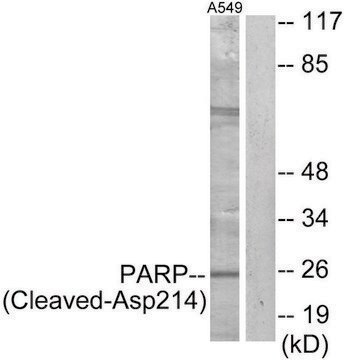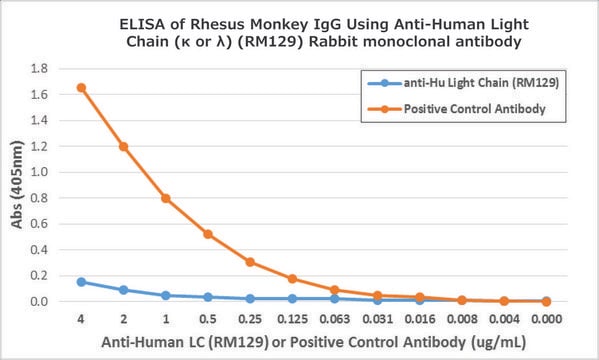General description
We are committed to bringing you greener alternative products, which adhere to one or more of The 12 Principles of Green Chemistry.This antibody is Preservative-free, produced without the harm or sacrifice of animals and exceptionally stable to allow for ambient shipping and storage if needed and thus aligns with "Waste Prevention", "Designing Safer Chemicals" and "Design for Energy Efficiency".
Click here for more information.
ZooMAb® antibodies represent an entirely new generation of recombinant monoclonal antibodies. Each ZooMAb® antibody is manufactured using our proprietary recombinant expression system, purified to homogeneity, and precisely dispensed to produce robust and highly reproducible lot-to-lot consistency. Only top-performing clones are released for use by researchers. Each antibody is validated for high specificity and affinity across multiple applications, including its most commonly used application. ZooMAb® antibodies are reliably available and ready to ship when you need them.
Specificity
Clone 1L6 is a ZooMAb® rabbit recombinant monoclonal antibody that specifically detects S100A12 protein. It targets an epitope within 22 amino acids from the internal region.
Immunogen
KLH-conjugated linear peptide corresponding to 22 amino acids from the internal region of human S100A12.
application
Quality Control Testing
Evaluated by Western Blotting with full-length recombinant Human S100A12.
Western Blotting Analysis (WB): A 1:1,000 dilution of this antibody detected full-length recombinant Human S100A12.
Tested Applications
Immunohistochemistry (Paraffin) Analysis: A 1:1,000 dilution of this antibody detected S100A12 in Human bone marrow tissue sections.
Affinity Binding Assay: A representative lot of this antibody bound S100A12 peptide with a KD of 1.8 x 10-7 in an affinity binding assay.
Immunocytochemistry Analysis: A 1:100 dilution from a representative lot detected S100A12 in HeLa cells.
Note: Actual optimal working dilutions must be determined by end user as specimens, and experimental conditions may vary with the end user..
Target description
Protein S100-A12 (UniProt: P80511; also known as CGRP, Calcium-binding protein in amniotic fluid 1, CAAF1, Calgranulin-C, CAGC, Extracellular newly identified RAGE-binding protein, EN-RAGE, Migration inhibitory factor-related protein 6, MRP-6, Neutrophil S100 protein, S100 calcium-binding protein A12) is encoded by the S100A12 gene (Gene ID: 6283) in human. S100A12 is a member of the S100 family of calcium-binding proteins that exists as a homodimer but can form tetramers or hexamers in the presence of calcium, zinc, and copper ions. It is predominantly expressed by neutrophils, monocytes, and activated macrophages. Its expression is also observed in eosinophils and macrophages in asthmatic airways in regions where mast cells accumulate. Its best-known target is RAGE (receptor for advanced glycation end products). It is predominantly localized in the cytoplasm, however, upon elevation of the intracellular calcium level, it translocates from the cytoplasm to the cytoskeleton and the cell membrane. It contains two EF-hand domains (aa 13-48 and 49-84) and a hinge region (aa 38-53). Each EF-domain can bind to one calcium ion that changes its conformation resulting in a concave hydrophobic surface in the C-terminal region. This forms a target recognition site thus enabling selective interaction with a host of specific protein or peptide targets. S100A12 plays a prominent role in the regulation of inflammatory processes and immune response. Its pro-inflammatory activity involves recruitment of leukocytes, promotion of cytokine and chemokine production, and regulation of leukocyte adhesion and migration. It acts as an alarmin, or a danger associated molecular pattern (DAMP) molecule and stimulates innate immune cells via binding to receptor for advanced glycation end products (AGER). Binding to AGER activates the MAP-kinase and NF-kB signaling pathways leading to production of pro-inflammatory cytokines and up-regulation of cell adhesion molecules ICAM1 and VCAM1. This ZooMAb® recombinant monoclonal antibody, generated by our propriety technology, offers significantly enhanced specificity, affinity, reproducibility, and stability over conventional monoclonals. (Ref.: Meijer, B., et al. (2012). Int. J. Inflam. 2012: 907078; Moroz, MV., et al. (2009). BMC Biochem. 10; 11; Yang, Z., et al. (2007). J. Allergy Clin. Immunol. 119(1); 106-114).
Physical form
Purified recombinant rabbit monoclonal antibody IgG, lyophilized in PBS with 5% Trehalose, normal appearance a coarse or translucent resin. The PBS/trehalose components in the ZooMAb formulation can have the appearance of a semi-solid (bead like gel) after lyophilization. This is a normal phenomenon. Please follow the recommended reconstitution procedure in the data sheet to dissolve the semi-solid, bead-like, gel-appearing material. The resulting antibody solution is completely stable and functional as proven by full functional testing. Contains no biocide or preservatives, such as azide, or any animal by-products. Larger pack sizes provided as multiples of 25 µL.
Reconstitution
300 µg/mL after reconstitution at 25 µL per vial. Please refer to guidance on suggested starting dilutions and/or titers per application and sample type.
Storage and Stability
Recommend storage of lyophilized product at 2-8°C; Before reconstitution, micro-centrifuge vials briefly to spin down material to bottom of the vial; Reconstitute each vial by adding 25 µL of filtered lab grade water or PBS; Reconstituted antibodies can be stored at 2-8°C, or -20°C for long term storage. Avoid repeated freeze-thaws.
Legal Information
ZooMAb is a registered trademark of Merck KGaA, Darmstadt, Germany
Disclaimer
Unless otherwise stated in our catalog or other company documentation accompanying the product(s), our products are intended for research use only and are not to be used for any other purpose, which includes but is not limited to, unauthorized commercial uses, in vitro diagnostic uses, ex vivo or in vivo therapeutic uses or any type of consumption or application to humans or animals.







